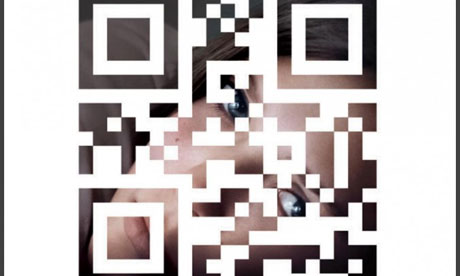
Using an image from currently-fashionable technology in a movie poster risks producing an image that will date quickly, and that will almost certainly be the case with this striking poster for Martha Marcy May Marlene - but then film adverts are not principally designed with posterity in mind.
The poster is based around a QR code, a form of barcode that can hold much more data than the traditional version, including links to videos and websites. QR codes have been around since the 1990s but have become increasingly popular in the UK in the last year or two because smartphones such as the iPhone are able to read them.
Many businesses have started to incorporate them as a design element, but this is the first time I have seen a film poster do so – although strangely the QR code on the poster does not actually seem to contain any information.
Whether or not it will date, for now, to my mind, the Martha Marcy May Marlene image looks attractively elegant and modern. But more importantly it fits neatly with the the themes of identity the film is built around.
The QR code in the poster hides or gradually reveals an image of the film's star, Martha (Elizabeth Olsen, younger sister of the former child stars the Olsen twins), who has fled a cult where she was given the name Marcy May. (All the women in the cult also have to use the name Marlene when they answer the phone.) The film flashes back and forth from the present, when Martha is living with her sister and her husband in their spacious lakeside home, to her life in the cult, under the spell of charismatic leader Patrick (John Hawkes).
The idea of Martha's identity being hidden behind a layer of something fits neatly with this premise. That this layer needs to be decoded before it can be understood also seems apt. In addition, the image is strongly suggestive of Martha's imprisonment: her eyes gaze out from behind the code as if from behind the bars of a jail cell, while the framing of the image, the thick white margins either side of it and the way the name of the film and its stars are squared off so neatly all seem to contribute to boxing Olsen in. She seems trapped behind the poster, rather than a part of it.
As the trailer shows (above at 1min 29s), when the film uses the same image, director Sean Durkin frames her face in a similar way, this time behind the bars of curtains or an opening door.
Another version of the poster (left) uses the same image but with an M replacing the QR code - essentially a more conventional version of the same idea.
The principal poster for the film (below left) takes a different approach, emphasising the dual identities of Martha and Marcy May by merging two photographs of Olsen's face to create a gauzy, sundrenched image.
Jack Crossing of Empire Design, the company responsible for main poster as well as well-received ads for Drive and A Single Man, said he had wanted to create something that was "beautiful but also haunting", just as the film was.
"It was basically trying to capture that beautiful feel," he said, but with hints of something "horrific" involved too.
His intention in overlaying the two images had been that "you didn't know where one started and one finished". Olsen's hair blowing in the breeze in the left-hand image was meant to represent her freedom in the present day, he said, while the blurred image of Patrick hanging in the background was intended to give the right-hand picture a menacing feel.
• Martha Marcy May Marlene is out now

